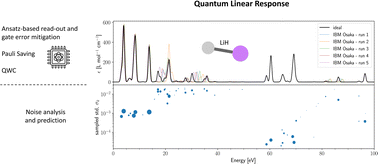The promise of quantum computing to circumvent the exponential scaling of quantum chemistry has sparked a race to develop chemistry algorithms for quantum architecture. However, most works neglect the quantum-inherent shot noise, let alone the effect of current noisy devices. Here, we present a comprehensive study of quantum linear response (qLR) theory obtaining spectroscopic properties on simulated fault-tolerant quantum computers and present-day near-term quantum hardware. This work introduces novel metrics to analyze and predict the origins of noise in the quantum algorithm, proposes an Ansatz-based error mitigation technique, and reveals the significant impact of Pauli saving in reducing measurement costs and noise in subspace methods. Our hardware results using up to cc-pVTZ basis set serve as proof of principle for obtaining absorption spectra on quantum hardware in a general approach with the accuracy of classical multi-configurational methods. Importantly, our results exemplify that substantial improvements in hardware error rates and measurement speed are necessary to lift quantum computational chemistry from proof of concept to an actual impact in the field.


